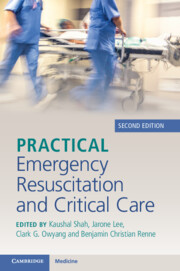Book contents
- Practical Emergency Resuscitation and Critical Care
- Practical Emergency Resuscitation and Critical Care
- Copyright page
- Contents
- Contributors
- Preface
- Section 1 General Critical Care
- Section 2 Infectious Disease Emergencies
- Section 3 Neurological Emergencies
- Section 4 Cardiovascular Emergencies
- Section 5 Respiratory Emergencies
- Section 6 Gastrointestinal Emergencies
- Section 7 Renal Emergencies
- Section 8 Hematology–Oncology Emergencies
- Section 9 Endocrine Emergencies
- Section 10 Environmental Emergencies
- Section 11 Trauma
- 47 General Trauma Principles
- 48 Severe Traumatic Brain Injury
- 49 Neck Trauma
- 50 Thoracic Trauma
- 51 Solid Organ Abdominal Trauma
- 52 Severe Pelvic Trauma
- 53 Soft Tissue Injury
- 54 Burn Resuscitation
- Section 12 End of Life
- Index
- References
51 - Solid Organ Abdominal Trauma
from Section 11 - Trauma
Published online by Cambridge University Press: 02 November 2023
- Practical Emergency Resuscitation and Critical Care
- Practical Emergency Resuscitation and Critical Care
- Copyright page
- Contents
- Contributors
- Preface
- Section 1 General Critical Care
- Section 2 Infectious Disease Emergencies
- Section 3 Neurological Emergencies
- Section 4 Cardiovascular Emergencies
- Section 5 Respiratory Emergencies
- Section 6 Gastrointestinal Emergencies
- Section 7 Renal Emergencies
- Section 8 Hematology–Oncology Emergencies
- Section 9 Endocrine Emergencies
- Section 10 Environmental Emergencies
- Section 11 Trauma
- 47 General Trauma Principles
- 48 Severe Traumatic Brain Injury
- 49 Neck Trauma
- 50 Thoracic Trauma
- 51 Solid Organ Abdominal Trauma
- 52 Severe Pelvic Trauma
- 53 Soft Tissue Injury
- 54 Burn Resuscitation
- Section 12 End of Life
- Index
- References
Summary
Injuries are generally classified based on mechanism as either blunt or penetrating. Each has a different method of evaluation and treatment.
In blunt injuries, solid organs are commonly injured with acceleration/deceleration injuries (i.e., motor vehicle collisions [MVC], falls from height) and crush injuries. Blunt injuries are associated with greater mortality than penetrating ones. The spleen is the most commonly injured solid organ, followed by the liver.
A stab wound, one such penetrating injury, is less likely to cause intra-abdominal injury and penetrate the peritoneum requiring surgical intervention when compared with projectile wounds.
- Type
- Chapter
- Information
- Practical Emergency Resuscitation and Critical Care , pp. 552 - 560Publisher: Cambridge University PressPrint publication year: 2023



